Introduction
This article is written in response to Dr R Nielsen’s scholarly article entitled The Forgotten Seven Thunders and published on this website on the 20 August 2008. (Please read it first, it can be found here ![]() It is good to see fresh ideas and attempts of interpretation of the Bible, but before we embrace anything as true we should check everything out as Bereans did: “every day they carefully examined the Scriptures to see whether what Paul said was true.” Ac17:11GW So, how does Dr R Nielsen’s article stand in relation to the Bible?
It is good to see fresh ideas and attempts of interpretation of the Bible, but before we embrace anything as true we should check everything out as Bereans did: “every day they carefully examined the Scriptures to see whether what Paul said was true.” Ac17:11GW So, how does Dr R Nielsen’s article stand in relation to the Bible?
First, I will construe Dr R Nielsen’s argument from basic propositions to the conclusion, and then consider the way Dr R Nielsen applies his findings to the members of the Seventh-day Adventist Church. Next, I will analyze most of the propositions he uses and show the results. Then I will talk about related issues and finally I will draw my own conclusions about Dr R Nielsen’s article.
The Main Argument
Dr R Nielsen begins his article by saying that the passage of Rv10:1–6 must refer to an important event. Later on he asserts that the 7 groups of events that he identified as global and critical are also important because “they affect us all and threaten our existence on this planet.” Then he challenges the readers with a question “What other seven groups of events could be more important than that?” It is obvious that for Dr R Nielsen the 7 groups of global events are the most important events on earth, therefore they are the only ones that qualify to match the voices of the 7 thunders. And so, we came to the first 2 propositions and a conclusion.
|
(1) |
The seven thunders play very important role in John’s writings. |
| (2) |
The seven global, critical groups of events are most important events on our planet. |
| (S) |
The seven thunders correspond with the seven global critical events. |
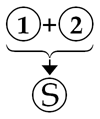
The graph above shows that the conclusion (S) is jointly supported be premises (1) and (2), or the premises (1) and (2) together infer the conclusion (S).
Dr R Nielsen describes that the 7 groups of events are the result of implementing his robust classification system invented for his research. He adds that the 7 groups were firmly established before he realized that there might be a connection between his research and the thunders of Rv10. This means that the number of groups of events is a natural outcome of Dr R Nielsen’s research.
|
(3) |
The number of groups of global, critical events is unbiased. |
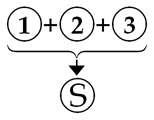
above is graph arg02.jpg
Proposition (3) on the graph above adds to the strength of the conclusion (C). Dr R Nielsen recalls that he attempted to disprove the connection between the 7 thunders and the 7 groups of global events, but his original classification was so robust that he failed to change it. Therefore, the number of groups of events must be correct.
|
(4) |
The number of groups of global critical events is correct. |
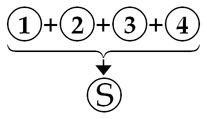
above is graph arg03.jpg
Dr R Nielsen explains that the discovery of the connection between the 7 thunders and the 7 groups of global events took place under unusual circumstances. As I see it, this episode is told with the purpose of strengthening of Dr R Nielsen’s argument. Therefore I will portray it in his argument as another proposition.
|
(5) |
The fact of unusual circumstances of the discovery shows that the interpretation of the seven thunders is correct. |
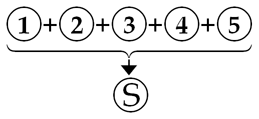
above is graph arg04.jpg
The title of Dr R Nielsen’s article contains a powerful word ‘forgotten.’ It seems that its purpose is to create urgency to return to some valuable teachings or practices that were abandoned probably unintentionally and without any specific reason. The article does not explain why something might have been forgotten, but knowing the importance of each word in a title I conclude that the word ‘forgotten’ did not make it to the title by coincidence. Therefore, even if it is only to produce a subliminal message accompanying the readers throughout the article, it deserves its own place as one of the premises in Dr R Nielsen’s argument.
|
(6) |
The placement of the word ‘forgotten’ in the title is carefully calculated to persuade the reader to accept conclusion of Dr R Nielsen’s argument. |
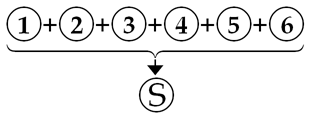
above is graph arg05.jpg
Dr R Nielsen explains that he was skeptical and unconvinced about any connection between the seven thunders of Revelation and the seven groups of global, critical events, therefore he decided to consult biblical scholars for advise. Such decision is a sign of honesty and contribute significantly to the truth-value of the whole argument. Therefore I will represent Dr R Nielsen’s attitude as another proposition in his argument.
|
(7) |
Theological matters are referred to biblical scholars (specialists in their field). |

above is graph arg06.jpg
Dr R Nielsen quotes Ellen White as saying that the thunders of Rv10 describe events. Therefore his discovery agrees with Ellen White’s statement, which further strengthens his argument.
|
(8) |
Ellen White agrees with Dr R Nielsen’s discovery. |

above is graph arg07.jpg
Dr R Nielsen is aware that some people may check up the Bible and quickly figure out that when John was about to write down what the seven thunders have said, a voice from heaven was heard “Seal up the things which the seven thunders uttered, and do not write them.” Rv10:4NKJV Therefore, Dr R Nielsen explains that “According to E G White, the expression seal up used in the Book of Revelation should not be understood as never to be revealed. The disclosure, that is, the identification of the seven thunders was supposed to be made at the time of the proclamation of the three-angels’ message, that is before the conclusion of all these dramatic developments.”
|
(9) |
Dr R Nielsen’s discovery does not interfere with the words “seal up.” |

above is graph arg08.jpg
And so, this is how I see Dr R Nielsen’s main argument. I repeat all propositions at this point for those who would like to see the whole argument in one place.
|
(1) |
The seven thunders play very important role in John’s writings. |
| (2) |
The seven global, critical groups of events are most important events on our planet. |
| (3) |
The number of groups of global, critical events is unbiased. |
| (4) |
The number (seven) of groups of global critical events is correct. |
| (5) |
The fact of unusual circumstances of the discovery shows that the interpretation of the seven thunders is correct. |
| (6) |
The placement of the word ‘forgotten’ in the title is carefully calculated to persuade the reader to accept conclusion of Dr R Nielsen’s argument. |
| (7) |
Theological matters are referred to biblical scholars (specialists in their field). |
| (8) |
Ellen White agrees with Dr R Nielsen’s discovery. |
| (9) |
Dr R Nielsen’s discovery does not interfere with the words “seal up.” |
| (S) |
The seven thunders correspond (perfect match) with the seven global critical events. |
The Uniqueness Argument
My analysis of this argument will be presented later on. Now, I will undertake to analyze the side argument that Dr R Nielsen uses in addition to his main argument.
To secure his interpretation of the 7 thunders of Rv10, Dr R Nielsen provides a side argument to show that his interpretation is the only one that qualifies for the purpose. He points out that those who “argue that the current critical global events … have nothing to do with the seven thunders but that the seven thunders will be revealed in the future, then we are quickly running out of time. The seven thunders should be already here. Where are they?” Further he adds that if some imaginary 7 thunders were to be still in the future, “these imaginative [sic] seven thunders would serve no useful purpose” because by this time “most, if not all, of the dramatic and important events will be over.” The relationship between propositions is shown in the graph below.
|
(21) |
The thunders must have commenced at the beginning of the 19th century (eg. 1801 or little later). |
| (22) |
At least some thunders must have made their appearance by now (year 2009). |
| (23) |
Nobody has identified any thunders (other than those mentioned by Dr R Nielsen). |
| (24) |
(therefore) There are no other thunders in the past. |
| (25) |
The future is too short to accommodate some other thunders (only those identified by Dr R Nielsen). |
| (26) |
Even if the future could accommodate some other thunders, they could not serve any useful purpose. |
| (27) |
(therefore) There could be no other thunders in the future. |
| (28) |
(joining part A and part B) There cannot possibly be any other events that could qualify for an interpretation of the 7 thunders of Rv10. |
| (U) |
The only possible interpretation of the 7 thunders of Rv10 are the 7 critical global events provided by Dr R Nielsen. |
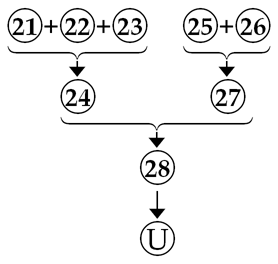
above is graph arg11.jpg
The Application of the Forgotten Seven Thunders
Based on his argument, Dr R Nielsen rebuffs Adventists for not acting on his interpretation of the 7 thunders. He raises several issues who are unclear and lack support:
What does Dr R Nielsen mean by all his remarks? Does he feel any obligation to rebuff Adventists for their bad behaviour? Does he have any authority to assess and correct the conduct of God’s people? I will address the issue in my response.
My Analysis—Application
I will begin with analysis of the application of the idea of the 7 critical global events being an interpretation of the 7 thunders of Rv10.
The title of the article contains the word ‘forgotten’ but it is not clear why the word is used there and what it is supposed to mean. Dr R Nielsen implies that the 7 thunders are forgotten and laments that we do “not pay attention to the forgotten seven thunders” or “how long will the seven thunders be forgotten by those who should be leading the world in understanding their special and timely meaning?” Unfortunately, he does not explain what these complaints mean. For instance, what is the “special and timely meaning” of the thunders, who are those who should be leading the world in understanding the meaning, and why he thinks that they supposed to be Adventists?
The word ‘forgotten’ in the title is obviously carefully selected (it would be wrong to do otherwise) but it remains unexplained. I will try to explain why this word might have been included in the title. It seems that Dr R Nielsen intends to make an impression that the thunders were once remembered as a precious virtue but are now forgotten probably without any particular reason. If this is true, then the word ‘forgotten’ would serve as a subliminal prompter to help people embrace the virgin interpretation of the 7 thunders. But obviously I am wrong in this case, therefore the word ‘forgotten’ remains a puzzle.
Dr R Nielsen implies that Adventists should lead “the world in understanding their special and timely message” but what is this special message? I suppose that the message should be related to the critical global events, but this would require people who are qualified in at least one trend or group of events. If there were some Adventists qualified to “lead the world,” how should they do it? And if there were no Adventists qualified, should they begin to study certain areas in order to become leaders and “lead the world” in something that so far was not defined? There are too many unknowns in Dr R Nielsen’s statement to make any meaningful analysis; therefore I will leave it at that.
Dr R Nielsen regrets that Adventists will not make a positive impression or wake up anyone. But why should they? Is anything wrong with not making impressions or not waking up people? Why should they wake anyone up if, in Dr R Nielsen’s own words, “the whole world is abuzz with the expressions of concern about the progression of the critical global events”? It seems there is no need to wake anyone up because everyone is already woken up, and there is no way to make a positive impression by announcing something that everybody already knows about.
Dr R Nielsen expresses his concern over Adventists who may “doze just a little longer and … miss it all.” But what will they miss—anything of value? It seems that Dr R Nielsen refers to the parable of the 10 virgins who fall asleep, but they were waiting for the Lord to come, therefore it has nothing to do with Dr R Nielsen’s research. I have no idea why biblical truths are mixed up with secular research.
Dr R Nielsen implies that Adventists, those who are expected to lead the world in understanding of the critical global events, are fast asleep according to Mt25:1–13 or intoxicated by self-praise and pride according to Rv3:17. But we must note that the parable of the 10 virgins does not describe inactivity in leading the world in teaching about the critical global events. Instead, the Bible focuses on inactivity in waiting for Jesus in state of readiness. Likewise, the reference to Rv3:17 seems to be out of place, because the pitiful condition of people refers to their spiritual state, in spite that the people consider themselves rich and satisfied in earthly matters. How, then, could Adventists be prevented from leading the world in teaching the global critical issues by their low spiritual condition? Do the current leaders demonstrate higher spiritual standing than Adventists? It may be true about some cases but there is no ground for sweeping generalizations. Referring to the Bible in both cases shows that Dr R Nielsen takes the Bible out of context.
Dr R Nielsen asserts that Adventists are “totally blind and oblivious to anything and everything that is happening around them.” But this far-reaching exaggerating statement is a public insult to any person. No one is “totally blind and oblivious to anything and everything that is happening around them.” In addition, every person has their own dignity and should not be humiliated by anybody with such statements, even if they were true to some degree. How much more does it refer to those who take the Bible in their hands and begin to preach! I feel that Dr R Nielsen owes public apology to all who read his article.
It is worth to note that at the beginning of his interpretation adventure Dr R Nielsen decided to consult biblical scholars, because they would know better than him. After checking some Bible commentaries he decided they contain nothing of value in regard to the 7 thunders of Rv10. Next he quoted Ellen White to get her authority in regard to his research, and finally he began to interpret the Bible himself and throws some unkind challenges in the face of Seventh-day Adventists for not following his research.
Dr R Nielsen ends his article with a statement from the Bible “For if the trumpet give an uncertain sound, who shall prepare himself to the battle?” Ironically, this statement appears immediately after 2 paragraphs addressing those who supposedly forgot the seven thunders, do not make any efforts to understand them, fail to learn in which time they live, do not study the trends, miss their opportunity to share, and some other unclear statements. It seems that after the 2 concluding paragraphs, readers might have no idea what Dr R Nielsen wants, and attribute the uncertain sound of the trumpet to his own writing. This is certainly what I have done, because Dr R Nielsen’s presents his rebuffs in a very unclear way which matches perfectly the biblical text that he quotes.
My conclusion is that Dr R Nielsen failed to describe clearly how his interpretation of the 7 thunders applies to Adventists, because his research and the 7 thunders do not have much in common, if anything at all. The section where he rebuffs Adventists for something unidentified lacks logic and structure, therefore I cannot produce any graphical representation of it. Therefore I conclude that Dr R Nielsen went out of rails before he finished his interpretation of the 7 thunders. The purpose of writing his article remains to me unclear.
My Analysis—The Uniqueness Argument
Now I will analyze the uniqueness argument to see its validity. At this stage I assume that premises (21) and (22) are true, and will focus on proposition (23).
|
(21) |
The thunders must have commenced at the beginning of the 19th century (eg. 1801 or little later). |
| (22) |
At least some thunders must have made their appearance by now (year 2009). |
| (23) |
Nobody has identified any thunders (other than those mentioned by Dr R Nielsen). |
| (24) |
(therefore) There are no other thunders in the past. |
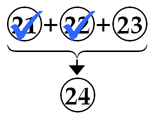
above is graph arg12.jpg
My question is: How could proposition (23) infer the intermediate conclusion (24)? Truth-values of propositions (21) and (22) are insignificant in this case (they only define the time). However, the fact that nobody has identified or proposed any events for an interpretation of the 7 thunders does not infer that there are none. Let us see if there are any events that might qualify for the interpretation of a thunder. For instance, the Great Leonid Meteor Storm of 1833 ![]()
![]() is so far unmatched by any other meteorite shower. And if there were other, greater meteorite showers later on, there would be a trend of increasing meteorite showers (Dr R Nielsen should agree with this idea because he uses events and trends interchangeably). But has he considered (and ruled out) the possibility of this event to contend for one of the 7 thunders of Rv10?
is so far unmatched by any other meteorite shower. And if there were other, greater meteorite showers later on, there would be a trend of increasing meteorite showers (Dr R Nielsen should agree with this idea because he uses events and trends interchangeably). But has he considered (and ruled out) the possibility of this event to contend for one of the 7 thunders of Rv10?
Another event might be for example Colony Collapse Disorder (known as sudden bee colonies disappearance), Mad Cow infectious disease, the 2004 Indian Ocean earthquake (tsunami, estimated to have released the energy of 23,000 Hiroshima-type atomic bombs) and so on. ![]()
So, it is not enough to ask a question if anybody identified any events as interpretation of the 7 thunders to support the idea that Dr R Nielsen’s interpretation is right. Another option might be that those intellectuals who could investigate events in recent history and provide alternative interpretation of the 7 thunders do not care enough (or have no time, etc.) to pursue such projects or publish their results. My conclusion is that proposition (23) has no support, and it is hard to see how it could possibly be true. Therefore I give it the truth-value of Ø (false, not true). It means that Dr R Nielsen did not show any support for his conclusion (proposition (24)) that there are no events in the past that could be used for the interpretation of some of the 7 thunders of Rv10.
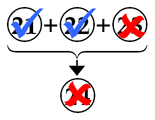
above is graph arg13.jpg
In part B of the uniqueness argument, both propositions (25) and (26) are not obvious and have no support whatsoever. Why should they be true?
| (25) |
The future is too short to accommodate some other thunders (only those identified by Dr R Nielsen). |
| (26) |
Even if the future could accommodate some other thunders, they could not serve any useful purpose. |
| (27) |
(therefore) There could be no other thunders in the future. |
My question in regard to this part of Dr R Nielsen’s argument is: Why should anyone accept the idea that the future is too short for accommodating some or even all 7 yet unknown thunders? If events like the 2004 tsunami or the 1986 Chernobyl disaster or the 1945 Hiroshima and Nagasaki bombings are good enough examples of some future events that may qualify for the thunders (and I believe they are), then the 7 thunders could easily fall on our planet as a matter of a few days or even hours! As I see it, before “the window of opportunity” closes on us some years in the future (10 years or less), many supernatural events may take place, and many strings of 7 events or trends may be identified. My conclusion therefore is that proposition (25) has no support, and it is hard to see how it could possibly be true. Therefore I give it the truth-value of Ø.
In regard to proposition (26) I wonder why the lack of any useful purpose of any future thunders could prevent them from being accepted as legitimate thunders? Why should they have any useful purpose? Whether they have or not any useful purpose, I do not see why it should have any bearing on qualifying some particular event for an interpretation of a thunder of Rv10 and Dr R Nielsen fails to provide one. My conclusion is that proposition (26) has no support, and it is hard to see how it could possibly be true. Therefore I give it the truth-value of Ø.
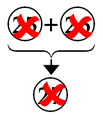
above is graph arg14.jpg
Now I will summarize my complete analysis of Dr R Nielsen’s uniqueness argument. Only propositions (21) and (22) are assumed to be true, but they do not affect the truth-value of the whole argument, and all other propositions lack any support. In other words, Dr R Nielsen did not prove at all that the 7 groups of events from his research are the only possible interpretation of the 7 thunders of Rv10.

above is graph arg15.jpg
Below, I repeat all propositions included in this argument for those who would like to see them together with the above chart.
|
(21) |
The thunders must have commenced at the beginning of the 19th century (eg. 1801 or little later). |
| (22) |
At least some thunders must have made their appearance by now (year 2009). |
| (23) |
Nobody has identified any thunders (other than those mentioned by Dr R Nielsen). |
| (24) |
(therefore) There are no other thunders in the past. |
| (25) |
The future is too short to accommodate some other thunders (only those identified by Dr R Nielsen). |
| (26) |
Even if the future could accommodate some other thunders, they could not serve any useful purpose. |
| (27) |
(therefore) There could be no other thunders in the future. |
| (28) |
(joining part A and part B) There cannot possibly be any other events that could qualify for an interpretation of the 7 thunders of Rv10. |
| (U) |
The only possible interpretation of the 7 thunders of Rv10 are the 7 critical global events provided by Dr R Nielsen. |
My analysis has demonstrated that the uniqueness argument is not sound (the structure and inferences may be valid, but the truth-values of propositions were not proved to be true), and propositions (21) and (22), even if true, could not make it sound. Therefore I conclude that Dr R Nielsen’s 7 global critical trends/events does not have to be the only possible interpretation of Rv10, and later on I will propose an alternative interpretation.
My Analysis—The Main Argument
Now I will analyse Dr R Nielsen’s main argument to see how strong it is on its own, after the uniqueness argument is proved to be unsound. The final graph of Dr R Nielsen’s argument is repeated below. It shows that the argument needs many propositions to collectively support just one conclusion.

above is graph arg07.jpg
As I have mentioned above, the reason for the word ‘forgotten’ in the title of Dr R Nielsen’s article is unclear. He uses it 2 times (apart from the title), and each time it occurs in a question without throwing any light on its specific usage. Because it lacks any support, it is unclear what it means, I have to assign the truth-value of Ø to proposition (6).

above is graph arg21.jpg
The word ‘forgotten’ in the title is obviously carefully selected (it would be wrong to do otherwise) but it remains unexplained. I will try to explain why this word might have been included in the title. It seems that Dr R Nielsen intends to make an impression that the thunders were once remembered as a precious virtue but are now forgotten probably without any particular reason. If this were true, then the word ‘forgotten’ would serve as a subliminal prompter to help people embrace the virgin interpretation of the 7 thunders. To give Dr R Nielsen the benefit of the doubt, I will withdraw this explanation. So, the word ‘forgotten’ remains a puzzle.
Dr R Nielsen explains that he was “still sceptical and unconvinced about any possible connection” between his research and the 7 thunders and “decided to consult biblical scholars. They should know better…” But because he could not find anything of value, he was satisfied with what “just one author” had said. What goes on here? Dr R Nielsen first made an impression that he was going to get expert advice, but was surprised to find nothing of any value. How did he decide that what he found was of no value? After all, he took matters into his own hands and assessed what the scholars said, instead of taking their advice? Does he mean that he knows better than those who “should know better”? Why did he assess scholars’ work as of no value? Is it because they did not provide any support for his view?
A little boy heard many times that he was brought to the world by a stork. But he did not understand how it could be done. So he jumped on the ’Net but looking all day he could not find how storks bring children to the world. Frustrated, he began to search for images of storks and he found one where a stork carries in his beak a nappy, and a little boy in it.

Satisfied with his research he settled the issue: storks bring boys to the world in nappies. What a difference would it make to the boy’s research if the boy consulted an ornithologist (bible scholar). He would have told the boy that his assumption was wrong, because storks do not bring boys or girls to the world. If Dr R Nielsen asked a knowledgeable theologian how to interpret the 7 thunders, he could probably receive the answer that the Bible does not provide enough information about the thunders to make any conclusions. Instead, he took some statements from Ellen White and decided that with her authority he himself is qualified to convince Adventists that he is right. There is nothing wrong with attempting to interpret the Bible, but why does he make an impression that he consulted experts on the matter? If he could not find anything of value in the sources he consulted, why should he mention about it at all—to make an impression that his interpretation comes from an authoritative source? This is not true, the interpretation does not come from a biblical scholar, as he promises, therefore I assign the truth-value of Ø to proposition (7).

above is graph arg22.jpg
Dr R Nielsen quotes Ellen White as saying that the thunders of Rv10 describe events. But he fails to see the second part of her statement where she says that these events “will be disclosed in their order.” These words surely imply that the events would be revealed in succession, while the groups of crucial global events described by Dr R Nielsen run all concurrently for about 200 years now! These events were identified only in recent years, when each group of events was well under way (except for one that will be described later on). Therefore I see that there is a clash between Ellen White’s explanation and Dr R Nielsen’s groups of events.
Recently I have contacted Pastor John Skrzypaszek, the Director of The Ellen G. White Research Centre in Cooranbong, Australia, ![]()
![]() and asked him to provide me with his point of view on the interpretation of the 7 thunders based on what Ellen White has ever wrote on the subject. Now I quote from his email:
and asked him to provide me with his point of view on the interpretation of the 7 thunders based on what Ellen White has ever wrote on the subject. Now I quote from his email:
“Ellen White makes only one major reference to the thunders which is found in Manuscript 59, 1900 in the section entitled "Jots and Tittles, II" August 16, 1900) Reprinted in MR Release 28. (Attached is the copy of the Ms). … Even thought it appears that she speak here about future unspecified events, as you read the entire context [you will see that] she continually emphasizes the experience of the Advent movement rather than end time events. … What follows is clearly Ellen White reference to the Millerite movement, the Great Disappointment. In fact further on, she refers to the period 1842 to 1844. … The emphasis of this entire passage is on the formative experience of the Advent movement. I cannot see any evidence that this statement is made with the view of some future events. Rather, it tends to justify and support the prophetic and historic foundations of the Advent experience. … To use this passage for any other purpose means to read into it one’s own assumptions.”
After reading such an expert’s advice on Ellen White, I cannot help but assign the truth-value of Ø to proposition (8).

above is graph arg23.jpg
Dr R Nielsen claims that his discovery took place under unusual circumstances. But is it to mean that such discoveries must be true? There are a lot of discoveries that take place under unusual circumstances yet they are not guaranteed to be true. Others, taken under usual circumstances, are not guaranteed to be false. There is no correlation between usual or unusual circumstances and the verity of the discovery. As I see it, circumstances do not decide whether Dr R Nielsen’s discoveries are true or false. Therefore I have to mark the inference from proposition (5) as invalid. (On the graph it is presented as if the proposition itself was proved to be false).

above is graph arg24.jpg
Dr R Nielsen argues that his classification system was in place before he realized the possibility of connection between his 7 groups of events and the 7 thunders of Rv10. This means that the number of groups of events is a natural outgrowth of his classification system, but we should be aware that this fact does not contribute to his argument in any way. It is required that his argument shows that the 7 thunders of Rv10 correspond with the 7 groups of critical global events, not their number. There may be many groups of 7 elements (churches, trumpets, seals, plagues), but the number of elements is not enough to draw a conclusion that these groups describe the same events. Even if it was so, why the crucial, global problems that threaten our existence are not compared with the seven last plagues, which will take place immediately before the end of the world and have the same character (disastrous) as global threats? Would it not be more logical connection?
We have an example in the Bible where kingdoms (or empires) are described in separate chapters, Dn7 and Dn8. In chapter 8 though the kingdom of Babylon is missing and we know that the other kingdoms correspond in spite of the first kingdom being missing. How do we know it? Because what we know about kingdoms 2, 3, and 4 shows us that we are talking about the same kingdoms. But if we looked at both chapters and focused on the number of kingdoms described, we would have to deny this correspondence. So, my conclusion is that the number of events is insufficient to decide whether the 7 critical global groups of events correspond with the 7 thunders of Rv10. Later on I will also analyze Dr R Nielsen’s classification and show that the number 7 (which triggered the idea of linking his research with the 7 thunders of Rv10) is incorrect. For now, I cannot help but assign the truth-value of Ø to the inference from proposition (4).

above is graph arg25.jpg
Dr R Nielsen argues that the instruction John heard from heaven about sealing “should not be understood as never to be revealed” and calls Ellen White’s authority to approve his point. But is such a move justifiable? Are there any places in the Bible that use similar expressions and would shed some light on the case of the 7 thunders being sealed?
Let us take the case from the Bible where God instructed to seal up the vision and explicitly stated “For it refers to many days in the future.” Dn8:26NKJV We see that in this case the words of the vision were written down, that God instruction to seal up the vision meant inability to understand the words, and when the required time would come, the meaning of the words would become known. In case of John, though, God does not specify how long the words would not be understood, because nothing was to be written in the first place. What could be “unsealed” if we have not even a clue what the 7 thunders were saying? So, how ‘nothing’ or ‘silence’ can be understood? God knew what He was saying, He said it exactly as He desired, and He is not going to change His mind for the rest of eternity. How can anyone argue that what God said is not what He meant?
In case of Daniel, the inability to understand was for some definite time, therefore God said that the vision “refers to many days in the future”, but in case of John God not only instructed John to not write anything about, but said that the words should be sealed (kept secret). If the words were to be revealed in the future, would not God tell us what these words were as it was in case of Daniel? As I see it, in case of John God knew what He was saying in the same manner as it was in Daniel’s vision. And because God did not say that the meaning would be revealed, and Dr R Nielsen does, than Dr R Nielsen adds to God’s Word something which is most likely not true. Therefore I have to assign the truth-value of Ø to proposition (9).

above is graph arg26.jpg
There are many important and less important things in everyone’s life. But do we ever claim that things are related in any way just because they are next to each other on our priority lists? A better chance for things to be related is when they are the most important. And still, there may be some things that are important for one person and completely negligible for another. So, how can one convince that what is the most important in one mind must also be the most important in another mind?
Dr R Nielsen begins his argument by asserting that the speeches of the 7 thunders are important. But how does he know it? Did he find it in the Bible? On one hand we may say that everything in the Bible is important. On the other hand there may be different levels of importance. To match the 7 groups of critical global events which he claims to be the most important events today (“What other 7 groups of events could not more important than that?”), Dr R Nielsen would need equally important biblical event. But the 7 speeches are not even written down! How can they be said to match the most important events from Dr R Nielsen’s research? Obviously, they had to be important for John, otherwise God would not show them in the vision. But for anybody else they may be important only in the sense that John was given some insight not available to his readers, therefore he knew what he was writing and we should not question it because we do not even know what he did know! So, the 7 thunders are not the most important events in the Bible, and the Bible never makes such a claim. Therefore I have a question: How does the perfect match work if the most important events on earth are claimed to correlate with just ordinarily important 7 thunders? How should we know that the 7 groups from Dr R Nielsen’s research need to be linked precisely with the 7 thunders and not with any other group of 7? How should we know that the 7 groups of events are in any way related to or predicted by some kind of hidden messages expressed by the 7 thunders? It seems to me that fusing the 7 groups of events with the 7 thunders of Rv10 lacks any support whatsoever.
Dr R Nielsen argues that the critical global groups of events are the most important because they all “threaten our existence on this planet.” But is this what the Bible tells us or it is only his explanation why he wants us to look at the results from his research as the most important? Obviously the Bible has different priorities for us than Dr R Nielsen. It is not concerned so much with the earthly things as with eternal things. “I have said this to you, so that in me you may have peace. In the world you face persecution. But take courage; I have conquered the world!” Jn16:33NRSV God’s priority is surely not to protect from all calamities in this life. “For those who want to save their life will lose it, and those who lose their life for my sake will save it.” Lk9:24NRSV Most important for God’s friends is to “strive first for the kingdom of God and his righteousness, and all these things will be given to [us] as well.” Mt6:33NRSV Luke asks “What does it profit them if they gain the whole world, but lose or forfeit themselves?” Lk9:25NRSV For me, eternal life is by far more important than survival on this planet, and this is what the Bible teaches. The biggest threat is not the progression of the current global critical events, as Dr R Nielsen suggests, but to abandon God.
There is an obvious mismatch between proposition (1) and (2) in Dr R Nielsen’s argument. Both propositions taken together cannot achieve anything on the way to conclusion (S), because they disagree with each other and the Bible. Therefore I assign the truth-value of both propositions to Ø.

above is graph arg27.jpg
Events or Trends or Else?
There is only one proposition in the (S) argument left to look at, and this proposition is responsible for the whole idea of linking Dr R Nielsen’s research with the Bible. The perfect number of the 7 groups of events has been firmly established before Dr R Nielsen’ min






Comments